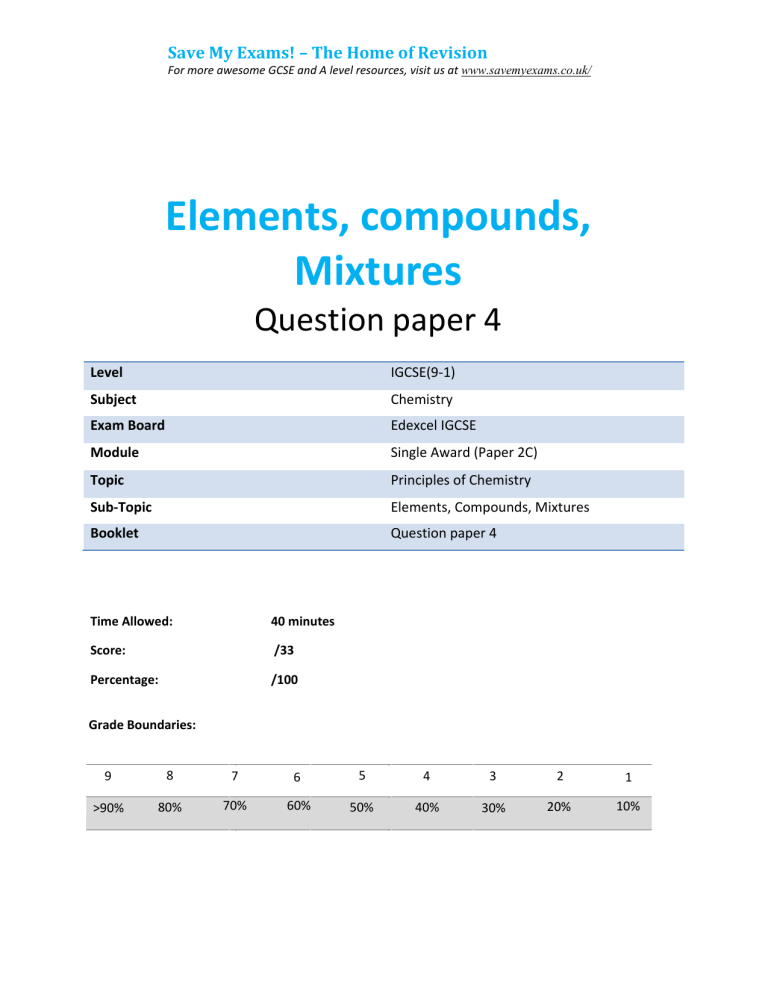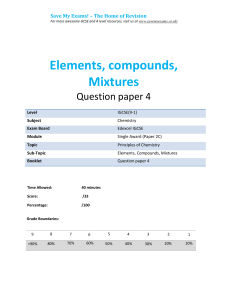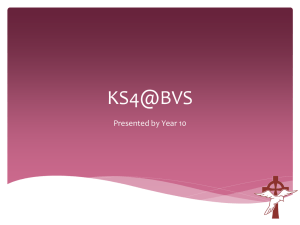2.4- elements compounds mixtures 2c - edexcel igcse 9-1 chemistry qp
advertisement

Save My Exams! – The Home of Revision For more awesome GCSE and A level resources, visit us at www.savemyexams.co.uk/ Elements, compounds, Mixtures Question paper 4 Level IGCSE(9-1) Subject Chemistry Exam Board Edexcel IGCSE Module Single Award (Paper 2C) Topic Principles of Chemistry Sub-Topic Elements, Compounds, Mixtures Booklet Question paper 4 Time Allowed: 40 minutes Score: /33 Percentage: /100 Grade Boundaries: 9 8 7 6 5 4 3 2 1 >90% 80% 70% 60% 50% 40% 30% 20% 10% Save My Exams! – The Home of Revision For more awesome GCSE and A level resources, visit us at www.savemyexams.co.uk/ 1 The diagram shows the apparatus a student uses to separate a mixture of salt and sand. She adds the mixture to water in a beaker and then carries out the three stages shown. X Y stage 1 stage 2 stage 3 (a) Give the names of the pieces of apparatus labelled X and Y. (2) X . . . . . .................................... . . . . . . . . . . . . . . . . . . . . . . . . . . . . . . . . . . . . . . . . . . . . . . . . . . . . . . . . . . . . . . . . . . . ............................................................................................................................................ . . . . .. . . . . . . . . . . . . . . . Y . . . . .................................... . . . . . . . . . . . . . . . . . . . . . . . . . . . . . . . . . . . . . . . . . . . . . . . . . . . . . . . . . . . . . . . . . . . . . ........................................................................................................................................... . . . . .. . . . . . . . . . . . . . . . (b) (i) A liquid that dissolves substances is a (1) A solute B solution C solvent D suspension (ii) The clear liquid that forms in stage 1 is a (1) A solute B solution C solvent D suspension Save My Exams! – The Home of Revision For more awesome GCSE and A level resources, visit us at www.savemyexams.co.uk/ (c) (i) At which stage, 1, 2 or 3, is the sand collected? (1) . . . . . . ................................... . . . . . . . . . . . . . . . . . . . . . . . . . . . . . . . . . . . . . . . . . . . . . . . . . . . . . . . . . . . . . . . . . . . . . ............................................................................................................................................ . . . . . . . . . . . . . . . . . . . . . . . . . . (ii) At which stage, 1, 2 or 3, is the salt collected? (1) . . . . . . ................................... . . . . . . . . . . . . . . . . . . . . . . . . . . . . . . . . . . . . . . . . . . . . . . . . . . . . . . . . . . . . . . . . . . . . . ............................................................................................................................................ . . . . . . . . . . . . . . . . . . . . . . . . . . (d) What happens to the water in stage 3? (1) . . . . . . ................................... . . . . . . . . . . . . . . . . . . . . . . . . . . . . . . . . . . . . . . . . . . . . . . . . . . . . . . . . . . . . . . . . . . . . . ............................................................................................................................................ . . . . . . . . . . . . . . . . . . . . . . . . . . . . . . . . ................................... . . . . . . . . . . . . . . . . . . . . . . . . . . . . . . . . . . . . . . . . . . . . . . . . . . . . . . . . . . . . . . . . . . . . . ............................................................................................................................................ . . . . . . . . . . . . . . . . . . . . . . . . . . (Total for Question 1 = 7 marks) Save My Exams! – The Home of Revision For more awesome GCSE and A level resources, visit us at www.savemyexams.co.uk/ 2 A student investigates some food colourings, each of which is made up of one or more dyes. She produces a chromatogram using the safe colourings red (SR), blue (SB) and green (SG) and food colourings red (FR), blue (FB) and green (FG). The diagram shows her chromatogram. SR SB SG FR FB FG reference line (a) How many dyes are there in SR? (1) A 1 B 2 C 3 D 4 (b) Complete the table by placing ticks (9) next to the two food colourings that are definitely safe to use. Explain your answer. (2) Food colouring Safe to use? FR FB FG explanation .......... . . . . . . . . . . . . . . . . . . . . . . . . . . . . . . . . . . . . . . . . . . . . . . . . . . . . . . . . . . . . . . . . . . . . . ........................................................................................................................................... . . . . . . . . . . . . . . . . . . . . . . . . . . . . . . . . .................................... . . . . . . . . . . . . . . . . . . . . . . . . . . . . . . . . . . . . . . . . . . . . . . . . . . . . . . . . . . . . . . . . . . . . ............................................................................................................................................ . . .. . . . . . . . . . . . . . . . . . . . . . . . . . . . . .................................... . . . . . . . . . . . . . . . . . . . . . . . . . . . . . . . . . . . . . . . . . . . . . . . . . . . . . . . . . . . . . . . . . . . . ............................................................................................................................................ . . .. . . . . . . . . . . . . . . . . . . . . . (Total for Question 2 = 3 marks) Save My Exams! – The Home of Revision For more awesome GCSE and A level resources, visit us at www.savemyexams.co.uk/ 3 The box shows some methods that can be used in separating mixtures. crystallisation t paper chromatography dissolving evaporation ration simple distillation fractional distillation From the box, select the best method for each of the separations. You may use each method once, more than once or not at all. (a) Removing sand from a mixture of sand and water. (1) . . . . . . .................................... . . . . . . . . . . . . . . . . . . . . . . . . . . . . . . . . . . . . . . . . . . . . . . . . . . . . . . . . . . . . . . . . . . . . . ........................................................................................................................................... . . . . . . . . . . . . . . . . . . . . . . . . . . (b) Obtaining pure water from a salt solution. (1) . . . . . . .................................... . . . . . . . . . . . . . . . . . . . . . . . . . . . . . . . . . . . . . . . . . . . . . . . . . . . . . . . . . . . . . . . . . . . . . ........................................................................................................................................... . . . . . . . . . . . . . . . . . . . . . . . . . . (c) Extracting the red dye from a sample of rose petals. (1) . . . . . . .................................... . . . . . . . . . . . . . . . . . . . . . . . . . . . . . . . . . . . . . . . . . . . . . . . . . . . . . . . . . . . . . . . . . . . . . ........................................................................................................................................... . . . . . . . . . . . . . . . . . . . . . . . . . . (d) Separating the coloured dyes in a sample of green ink. (1) . . . . . . .................................... . . . . . . . . . . . . . . . . . . . . . . . . . . . . . . . . . . . . . . . . . . . . . . . . . . . . . . . . . . . . . . . . . . . . . ........................................................................................................................................... . . . . . . . . . . . . . . . . . . . . . . . . . . (e) Obtaining ethanol (alcohol) from a mixture of ethanol and water. (1) . . . . . . .................................... . . . . . . . . . . . . . . . . . . . . . . . . . . . . . . . . . . . . . . . . . . . . . . . . . . . . . . . . . . . . . . . . . . . . . ........................................................................................................................................... . . . . . . . . . . . . . . . . . . . . . . . . . . (Total for Question 3 = 5 marks) Save My Exams! – The Home of Revision For more awesome GCSE and A level resources, visit us at www.savemyexams.co.uk/ 4 (a) The list shows some techniques used to separate mixtures. A crystallisation B filtration C fractional distillation D paper chromatography E simple distillation Complete the table to show the best method of obtaining each substance from the mixture. In each case, choose one of the letters A, B, C, D or E. Each letter may be used once, more than once or not at all. (4) Substance Mixture sand sand and water solid copper(II) sulfate aqueous copper(II) sulfate red food dye mixture of food dyes kerosene crude oil Letter (b) Gold occurs in ores, which are mixtures of gold and other substances. Several elements and compounds are used in the extraction of gold from its ores. Each box below represents the substances present in one part of the extraction process. Classify the contents of each box as a compound, an element or a mixture by writing your choice below each box. (3) Au Au NaCN NaCN H2O NaCN Au NaCN O2 H 2O NaCN H2O Compound, element or mixture (Total for Question 4 = 7 marks) Save My Exams! – The Home of Revision For more awesome GCSE and A level resources, visit us at www.savemyexams.co.uk/ 5 The table shows the names of some common pieces of laboratory apparatus used to make measurements. (a) Complete the table to show the name of the quantity that can be measured by each piece of apparatus, and a common unit used for that quantity. One example of each has been done for you. Apparatus balance stop clock Quantity (6) Unit mass s gas syringe ruler (b) Which piece of apparatus is needed to make measurements in a paper chromatography experiment? (1) A balance B gas syringe C ruler D stop clock (Total for Question 5 = 7 marks) Save My Exams! – The Home of Revision For more awesome GCSE and A level resources, visit us at www.savemyexams.co.uk/ 6 A student produces this chromatogram for four dyes, A, B, C and D. Blue Red Yellow A B C D (a) Put a cross ( ) in a box to indicate your answer. (i) Which one of the dyes contains three colours? (1) A B C D (ii) Which one of the dyes contains one colour only? (1) A B C D (b) Each dye is made from one or more of the colours blue, red and yellow. The student thinks that the result for one dye is incorrect. Suggest which result is incorrect. Explain your answer. (2) The incorrect result is . . . . . . . . . . . . . . . . . . . . . . . . . . . . . . . . . . . . . . . . . . . . . . . . . . . . .......................................................................... .................................................................. . . . . . . . . . . . . . . . . . . . . . . . . because ..................... . . . . . . . . . . . . . . . . . . . . . . . . . . . . . . . . . . . . . . . . . . . . . . . . . . . . . . . . . . . . . . . . . . . . ........................................................................................................................................... . . . . . . . . . . . . . . . . . . . . . . . . . . . . . . . . .................................... . . . . . . . . . . . . . . . . . . . . . . . . . . . . . . . . . . . . . . . . . . . . . . . . . . . . . . . . . . . . . . . . . . . . . ........................................................................................................................................... . .. . . . . . . . . . . . . . . . . . . . . . (Total for Question 6 = 4 marks)



